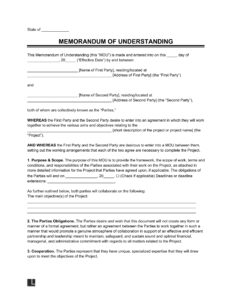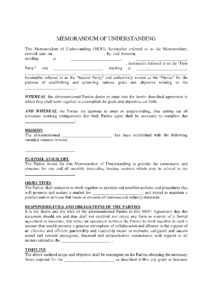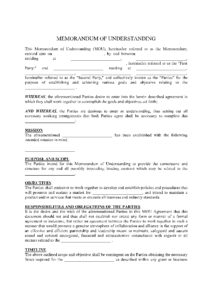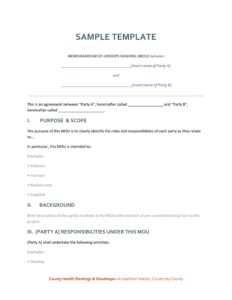Navigating the complexities of formal agreements between parties can often feel like a tricky dance. You want to ensure everyone is on the same page, roles are clear, and commitments are understood, but without immediately jumping into a full-blown, heavy-duty contract. This is where a Memorandum of Understanding, or MoU, traditionally comes into play, serving as a foundational document. It outlines the intentions and understanding between two or more parties, paving the way for future cooperation or a more detailed legal agreement.
However, sometimes you need something more robust than a simple statement of intent. There are situations where the understanding itself needs to carry legal weight from the outset, requiring that the document isn’t just a friendly handshake on paper, but a firm, enforceable commitment. This article will guide you through understanding when and how an MoU can become binding, and what elements are crucial for a truly effective and legally sound binding memorandum of understanding template.
Understanding the Binding Nature of an MOU
While many people associate a Memorandum of Understanding with a non-binding agreement that simply outlines intentions, it’s crucial to understand that an MoU can indeed be legally binding if certain conditions are met. The key difference lies not just in the title of the document, but in the language used and the intent of the parties involved. If the terms are sufficiently definite, and the parties intend to create legal relations, a court may interpret an MoU as a binding contract, regardless of its informal-sounding name.
For an MoU to transform from a declaration of good faith into a legally enforceable document, it generally needs to possess the fundamental elements of a contract. These elements are universally recognized in common law jurisdictions and are essential for any agreement to hold up in court. Without these components clearly articulated, even the most detailed MoU might only serve as a guidepost rather than a legally enforceable obligation.
Key Elements for Enforceability
To ensure your binding memorandum of understanding template holds up as a legal agreement, you must include and clearly define these core contractual elements:
- Offer and Acceptance: One party must propose a clear offer, and the other must unequivocally accept it.
- Consideration: There must be an exchange of something of value, whether it’s money, services, goods, or a promise to act or refrain from acting.
- Intention to Create Legal Relations: Both parties must intend for the agreement to be legally enforceable, rather than just a social or moral understanding.
- Certainty of Terms: The terms of the agreement must be clear, unambiguous, and complete, leaving no room for significant interpretation or dispute.
- Capacity: All parties signing the agreement must have the legal capacity to enter into a contract (e.g., of legal age, sound mind, authorized representative).
Common Misconceptions
It’s a common misconception that simply calling a document an "MoU" automatically renders it non-binding. This is not necessarily true. Courts often look beyond the title to the actual content and the intentions of the parties. If the language used is imperative (e.g., "shall," "will"), specific about obligations, and includes remedies for breach, it’s highly likely to be considered binding. Therefore, if you aim for a binding memorandum of understanding template, choose your words carefully and ensure they reflect a clear commitment.
Crafting Your Binding Memorandum of Understanding Template
When developing a binding memorandum of understanding template, precision is paramount. This isn’t just about filling in blanks; it’s about meticulously defining the relationship, responsibilities, and expectations of all parties involved to prevent future disagreements. The template should be comprehensive enough to cover all material aspects of the agreement, yet clear and concise to avoid ambiguity. Remember, a well-drafted template serves as a strong foundation for any collaborative venture, offering clarity and protection.
Always consider the specific context of your agreement. What are the unique aspects of this partnership? What risks need to be mitigated? What are the key deliverables and timelines? While a standard template provides a solid starting point, it’s often necessary to customize it extensively to fit the particular circumstances, ensuring it truly reflects the unique aspects of your arrangement and the specific obligations you intend to make legally enforceable.
Including explicit language stating the parties’ intent for the MoU to be legally binding is also a good practice. This removes any doubt about the document’s nature. Beyond that, a robust binding memorandum of understanding template should ideally include several key sections to ensure all bases are covered and the agreement is comprehensive:
- Parties Involved: Full legal names and addresses of all entities or individuals.
- Purpose and Scope: A clear statement outlining the objectives and boundaries of the agreement.
- Roles and Responsibilities: Detailed description of what each party is expected to do.
- Term and Termination: Start and end dates, and conditions under which the agreement can be terminated.
- Financials (if applicable): Any monetary contributions, payment schedules, or cost-sharing arrangements.
- Confidentiality: Provisions for protecting sensitive information shared between parties.
- Intellectual Property: Ownership and usage rights for any IP developed or shared.
- Dispute Resolution: The process for resolving conflicts, such as mediation or arbitration.
- Governing Law: The jurisdiction whose laws will apply to the agreement.
- Signatures: Spaces for authorized representatives to sign and date, indicating their assent.
A carefully constructed binding MoU serves as an invaluable tool for formalizing relationships and ensuring accountability. By meticulously outlining intentions and commitments within a legally enforceable framework, you establish a solid foundation for successful collaboration. This approach helps to minimize misunderstandings and provides a clear pathway forward, protecting the interests of all parties involved from the outset.
Taking the time to develop and properly execute such a document empowers you to proceed with confidence in your partnerships. It’s a proactive step in fostering trust and securing mutual objectives, ensuring that every party clearly understands their obligations and the legal implications of their agreement.



